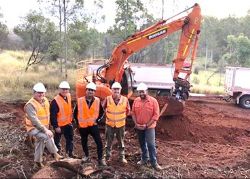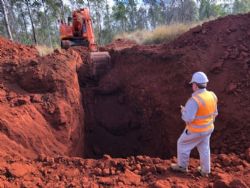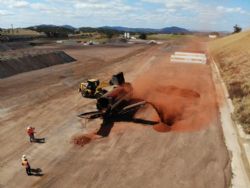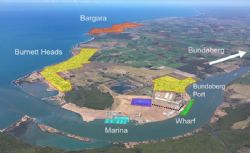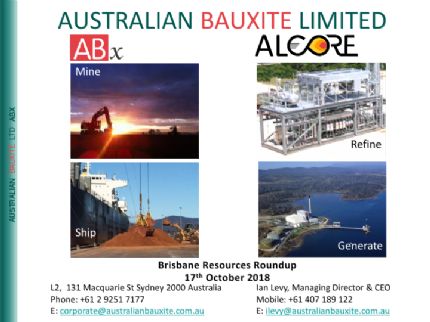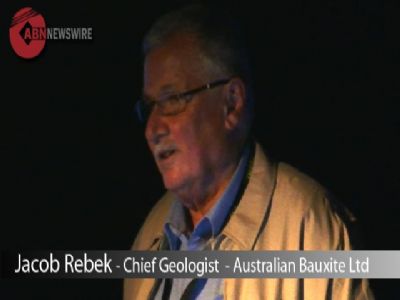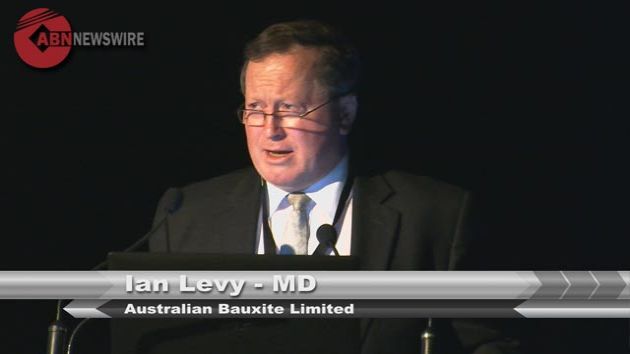Binjour Mine Lease Design Underway: Positive Bulk Sampling Results
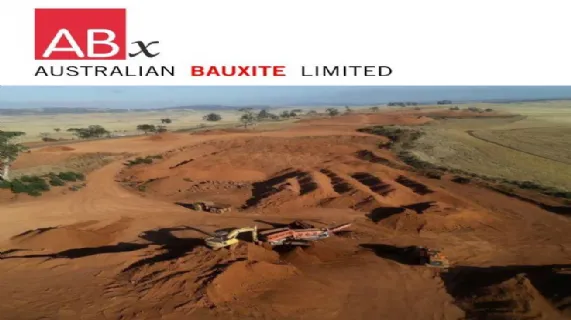
Binjour Mine Underway Following Positive Bulk Sampling
Sydney, Nov 25, 2019 AEST (ABN Newswire) - Bauxite producer, Australian Bauxite Limited ( ASX:ABX) (
ASX:ABX) ( A7B:FRA) considers its Binjour Project located 115kms southwest of Bundaberg Port to be the best source of gibbsite-trihydrate (THA) metallurgical grade bauxite in Queensland.
A7B:FRA) considers its Binjour Project located 115kms southwest of Bundaberg Port to be the best source of gibbsite-trihydrate (THA) metallurgical grade bauxite in Queensland.
Unlike other QLD bauxites, Binjour bauxite is ideal for low-temperature alumina refineries.
- ABx's bulk-sampling programs at Binjour QLD in 2019 have defined the optimum Mining Lease Application and clarified the mining-processing strategy for the project
- Results have confirmed that the project can operate at a bulk-scale mining and screening scale and achieve the required bauxite specifications
- A project summary and financial assessment will be reviewed by the ABx Board of Directors in mid-December. Progress of the Binjour project remains on schedule
- If ABx resolves to proceed, a Mining Lease Application will be lodged in early 2020
- Binjour project is fully-funded by ABx's marketing partner, Rawmin Mining of India which will also supply similar bauxite from its bauxite mines in India to the same customer that ABx will supply from Binjour. Seasonal synergies are achieved
- Both ABx and Rawmin intend to sell 0.5 to 1.5 million tonnes per year of gibbsite-rich trihydrate (THA) bauxite grading 44% to 45% Al2O3 and 5% SiO2 which is ideal for refining into alumina by low-temperature Bayer-process refineries
- Binjour bauxite resources total 37 million tonnes - see Resources Statement
- A tripartite sales MoU has been executed between ABx, Rawmin and Chinese aluminium producer Tianshan which is building an alumina refinery in Southern China that needs large supplies of the Binjour-type of bauxite starting end 2020
- ABx has also executed an MoU with the Port of Bundaberg to investigate the opportunity to export bauxite in bulk tonnages through the Port of Bundaberg
- Bulk sampling and screening has resolved mining issues, geological dilution risks, processing, environmental and ore performance characteristics that assist the design of the optimum Mining Lease Application, should ABx decide to proceed with a project
Coordination with stakeholders
ABx has worked at length with landholders, local government, state government, port authorities, mining contractors, processing companies, logistics companies, marketing specialists and bauxite customers to develop a viable strategy for the Binjour Bauxite Project to produce and deliver good quality metallurgical bauxite onto large bulk carrier ships at the Port of Bundaberg for export.
Port MoU agreement
On 30th May 2019, ABx announced that it had executed a Memorandum of Understanding agreement ("MoU") with the Port of Bundaberg to investigate its potential for:
1. Stockpiling bauxite of various grades from the Binjour project
2. Blending the bauxite to the contracted specification, and
3. Transhipping bauxite for loading 150,000 tonne bulk carrier ships within port boundaries.
Customer MoU agreement
On 2nd April 2019, ABx announced it had executed a tripartite MoU between ABx and its joint venture partner, Rawmin Mining and Industries of India with Tianshan Aluminium Co Ltd of China for the sale of 0.5 to 1.5 million tonnes of bauxite from the Binjour project and a similar tonnage from Rawmin's bauxite mines in India to Tianshan's new low temperature refinery in southern China which is due for completion during 2020.
BULK SAMPLING, PROCESSING & MINE LEASE APPLICATION DESIGN FACTORS
Bulk sampling & testwork was conducted in May, June and September, with assaying and lab tests continuing through November 2019 - see JORC Table 1* in appendix for details of procedures. ABx is scheduled to make a decision in mid-December 2019 regarding project development.
Screen performance: Two 28 tonne screen tests confirmed that Binjour bauxite screens superbly with high throughput rates and clean grade-size distributions which is an important bauxite attribute.
Dry-screening works superbly in dry-season
The dry-screening was impressively effective with each size fraction being free of carry-over of clays.
In fact, clays at Binjour are easily screened as long as it is done in the dry-season. The clays become sticky and difficult to handle when wet.
Seasonality: For these reasons, screening will mainly be done in the dry season (April-November) when humidity is very low at Binjour. The dry season is also the best time for shipping.
Crusher for oversize lumps
As shown in Figure 3*, the oversize fraction includes some lumps exceeding 100mm in size and will require crushing, probably on a quarterly campaign basis.
Deep high grade bauxite layer identified
The bulk sampling work also identified an extensive deep bauxite layer grading more than 48% Al2O3 and less than 3% SiO2 which is the highest quality gibbsite-trihydrate bauxite in eastern Australia.
Mining this deep bauxite requires removal of 6 to 10 metres of an overlying layer of red mudstone that is probably a sediment that accumulated across the region after the high grade bauxite was formed. This deeper mining will require confidence in strong market support from a customer that is prepared to pay extra for high-grade bauxite. ABx and Rawmin believe that the bauxite market will be short of high-grade in coming years and a strong relationship with a customer is likely.
Mining issues
These bulk sampling programs tested the geological nature of the rock units that affect mining production parameters including:
1. Dilution from red mud overburden
When red mud removal was done in close proximity to exposed bauxite, there was an increase in dilution from the red mud because it has a blocky, brick-like layer that is not identifiable in drill holes. These blocks easily break away and contaminate the extraction of the deeper layer of bauxite. Pre-stripping of large areas will be needed to minimise dilution.
2. Removal of red mud overburden
The red mud unit is best excavated on retreat from an open face where the confining pressures of the red mud unit have been relaxed. Bulk removal of overburden using scrapers is untested and remains as an upside potential.
3. Bauxite Extraction
Bauxite at Binjour is variable in strength and habit. It can be hard and blocky in places and within 10 to 20 metres, can be friable and free-digging. It is assumed that a large tonnage excavator (75 to 100 tonnes size) will be needed for mining all bauxite settings.
Results show that bulk-mined bauxite can meet the required saleable grades:
Logistics
Delivery of bauxite to the customer overseas is the largest cost and largest challenge for the Binjour project. At present, the expectations are that high-efficiency trucking over a road distance of 200kms to the Bundaberg Port will be required. This road haulage stage is the inhibiting factor for annual tonnages sold.
A site shown as the "MoU Block" in Figure 14* has been identified as a stockpile location that requires no trucking though the Bundaberg Port Village, is well shielded by surrounding scrub and has no mangroves along the river banks in that location.
To compensate for the high road haulage costs, ABx seeks to load large bulk carrier ships of the Cape Size class (110,000 tonnes bulk cargo) within the Port Limits of Bundaberg Port.
ABx favours the use of Bundaberg Port because it lies well south of the Great Barrier Reef Park and is sand-bottomed from the point of loading through to international shipping lanes. ABx has worked collegiately with Bundaberg Port management and with all stakeholders in the Wide Bay Burnett Region since 2010-11 when the discovery of the Binjour Bauxite deposit was made.
Logistics
Delivery of bauxite to the customer overseas is the largest cost and largest challenge for the Binjour project. At present, the expectations are that high-efficiency trucking over a road distance of 200kms to the Bundaberg Port will be required. This road haulage stage is the inhibiting factor for annual tonnages sold.
A site shown as the "MoU Block" in Figure 14* has been identified as a stockpile location that requires no trucking though the Bundaberg Port Village, is well shielded by surrounding scrub and has no mangroves along the river banks in that location.
To compensate for the high road haulage costs, ABx seeks to load large bulk carrier ships of the Cape Size class (110,000 tonnes bulk cargo) within the Port Limits of Bundaberg Port.
ABx favours the use of Bundaberg Port because it lies well south of the Great Barrier Reef Park and is sand-bottomed from the point of loading through to international shipping lanes. ABx has worked collegiately with Bundaberg Port management and with all stakeholders in the Wide Bay Burnett Region since 2010-11 when the discovery of the Binjour Bauxite deposit was made.
*To view tables and figures, please visit:
https://abnnewswire.net/lnk/H75T47X3
About ABx Group Limited
 ABx Group Limited (ABx) (ASX:ABX) started as a bauxite miner in Tasmania in 2014 & controls the Eastern Australian Bauxite Province. In 2020 to 2023, ABx also discovered Australia’s only true ionic adsorption clay Rare Earth Elements resource at Deep Leads in pine plantations 40km west of Launceston with a JORC-compliant resource of 89 million tonnes from only 29% of the mineralised outline, averaging 844 ppm total rare earth oxides that is the most enriched in the critically important rare earths, Dy and Tb, of any Australian REE deposit.
ABx Group Limited (ABx) (ASX:ABX) started as a bauxite miner in Tasmania in 2014 & controls the Eastern Australian Bauxite Province. In 2020 to 2023, ABx also discovered Australia’s only true ionic adsorption clay Rare Earth Elements resource at Deep Leads in pine plantations 40km west of Launceston with a JORC-compliant resource of 89 million tonnes from only 29% of the mineralised outline, averaging 844 ppm total rare earth oxides that is the most enriched in the critically important rare earths, Dy and Tb, of any Australian REE deposit.
ABx has also developed a proprietary technology to produce fluorine chemicals from an aluminium smelter waste product and return the fluorine back into the smelters, thus reducing reliance on imported aluminium fluoride.
ABx has committed a large proportion of its expenditure into Research and Development and has found ways to capitalise on the main strengths of its bauxite type which is very clean, free of all deleterious elements and can be separated into different product streams using physical, chemical and geophysical methods. It has produced and marketed specialist bauxite products for the manufacturers of fertiliser, cement with high late strength for major infrastructure such as bridges and is in the advanced stages of approvals for production of metallurgical bauxite from its Binjour Bauxite deposit with JORC-compliant resources of 37 million tonnes of bauxite, in a joint development with a Chinese-focussed Australian trading company Good Importing International.
ABx is also preparing to produce fertiliser grade and cement grade bauxite from its DL130 bauxite quarry in northern Tasmania, 40km west of Launceston. This quarry is sited in the middle of the large Deep Leads REE deposit and may one day be a site for heap leaching of the REE using a low-cost, benign leachate with the same acidity as apple juice or tea.
ABx endorses best practices on agricultural land, strives to leave land and environment better than we find it. We only operate where welcomed.
| ||
|



